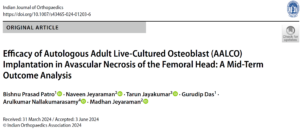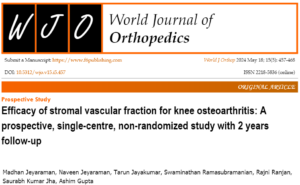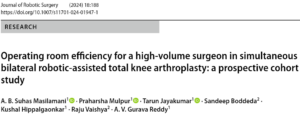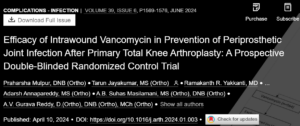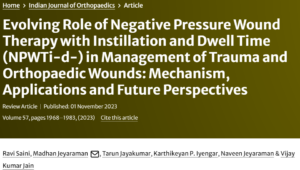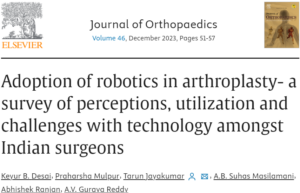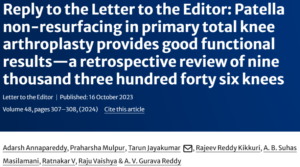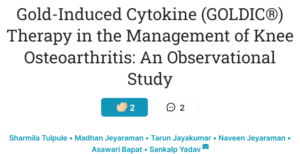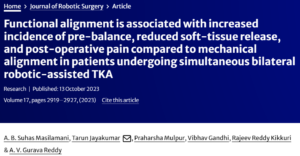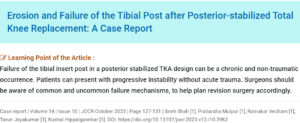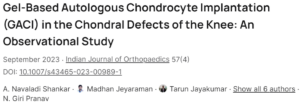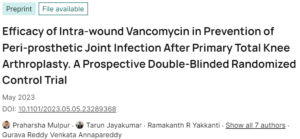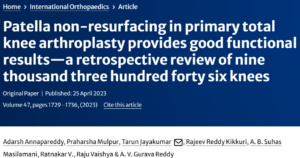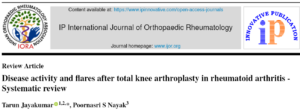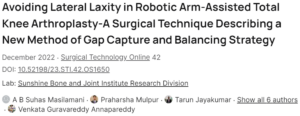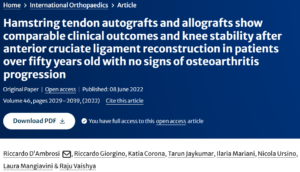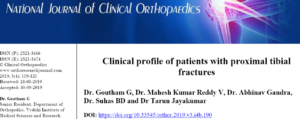



Active Involvement in Research and Conferences is of utmost priority to Dr. Tarun. He is actively involved in clinical research and scientific teaching programs, contributing to the advancement of orthopaedic knowledge and practice. He frequently attends and participates in national and international conferences, sharing his insights and learning from global experts in the field. His commitment to continuous learning and professional development underscores his dedication to providing the highest quality of care to his patients.
The combination of core decompression and AALCO implantation shows promise as an effective treatment for AVN of the femoral head, with notable improvements in functional and radiological outcomes. This study supports the potential of orthobiologic approaches in AVN treatment, warranting further investigation through comprehensive randomized controlled trials.
50 patients with Kellgren-Lawrence grades II and III OA. Patients were randomly assigned (1:1) to receive either a single intra-articular SVF injection (group A) or a single intra-articular ICS (triamcinolone) (group B) injection. Group A experienced a notable reduction in pain, with VAS scores decreasing from 7.7 to 2.4 over 24 months, compared to a minor reduction from 7.8 to 6.2 in Group B. Our study demonstrated that intra-articular administration of SVF can lead to reduced pain and improved knee function in patients with primary knee OA
The mean operating times of the final 50 RATKA at the end of 1 yearimproved by about 36 min with all the SB-RATKA cases being completed in under 120 min. The efficiency of SB-RATKAimproved significantly with time and experience, resulting in shorter operational times within a year, revealing the potentialof robotic-assisted surgery to surpass conventional approaches in TKA in terms of operating room efficiency
The paper examines the physiological impacts of Whole Body Cryotherapy on cardiovascular, musculoskeletal, hematologic, hormonal, and metabolic systems. Specific orthopaedic applications discussed include its role in the management of fractures, osteoarthritis, osteonecrosis of the femoral head, osteomyelitis, adhesive capsulitis, tendinopathies, rheumatic pathologies, chronic pain syndromes, and fibromyalgia. The study also highlights the benefits and drawbacks of WBC, including its potential to improve athletic performance, recovery, mood, and well-being, while noting risks like frostbite and impaired muscle strength. WBC shows promise in enhancing bone health in athletes and providing relief in osteoarthritis and fibromyalgia patients. The paper underscores the need for further research to establish standardised protocols and understand long-term effects.
Intrawound vancomycin powder does not appear to reduce PJI/SSI rate in primary total knee arthroplasties, including high-risk groups. Although safe from a renal perspective, intrawound vancomycin was associated with an increase in postoperative aseptic wound complications. Intrawound vancomycin may not be effective in reducing the rate of PJI in primary TKA.
Total joint replacement surgeries are standard procedures for managing end-stage hip or knee arthritis. Despite advances in technology, some patients experience dissatisfaction after total knee arthroplasty (TKA). Robotic technology has evolved significantly and has shown promise in improving component positioning, alignment, and surgical outcomes.
Posterior-stabilized (PS) total knee arthroplasty (TKA) prostheses are characterized by an articulation between the polyethylene tibial post and the cam of the femoral component. Tibial post-fractures, traumatic and non-traumatic, are uncommon but catastrophic complications. diseases such as knee OA, lumbar canal stenosis, Achilles tendinopathy,
Osteoarticular Tuberculosis (TB) of wrist joint is a rare, often misdiagnosed form of site affected by Mycobacterium Tuberculosis infection that can lead to severe disability and morbidity. This review aims to summarize the current literature on the diagnosis and management of Mycobacterium Tuberculosis infection of the wrist joint. diseases such as knee OA, lumbar canal stenosis, Achilles tendinopathy,
Patellar resurfacing has long been a contentious subject in TKA with no consensus and the literature yielding disparate results. The aim of this study was to evaluate the long-term functional outcomes and complications of patients undergoing primary TKA without patellar resurfacing (non-resurfacing).
Avascular necrosis (AVN) of the femoral head is a type of osteonecrosis with the disruption of blood supply to the head of the femur. Management of AVN femoral head depends on the stage of the disease. In this case report, we elaborated on the biological therapy for bilateral AVN of the femoral head.
Proximal humerus fractures are common and debilitating injuries and their incidence is increasing especially in elderly. Treatment of unstable, displaced, and comminuted fractures of the proximal humerus remains a challenging issue and significant controversy exists regarding the best method of treating these fractures.
Standard open reduction and internal fixation techniques have been successful in restoring osseous alignment for proximal tibial fractures; however, surgical morbidity, especially soft tissue infection and wound necrosis, has been reported frequently. For this reason, several investigators have proposed minimally invasive methods of fracture reduction.
A basic understanding of the mechanism of fracture production has always aided in the treatment of specific fractures. Tibial plateau fractures are usually caused by high velocity trauma causing valgus or rarely varus force with or without axial loading as in road traffic accidents (Bumper fracture) or fall from a height.
Low back pain is one of the most common and disabling morbidities in the world and its relationship with spino-pelvic parameters is not yet fully understood in the Indian population. Our objective was to study the spino-pelvic parameters in patients who presented to the OPD with low back ache (LBA).




